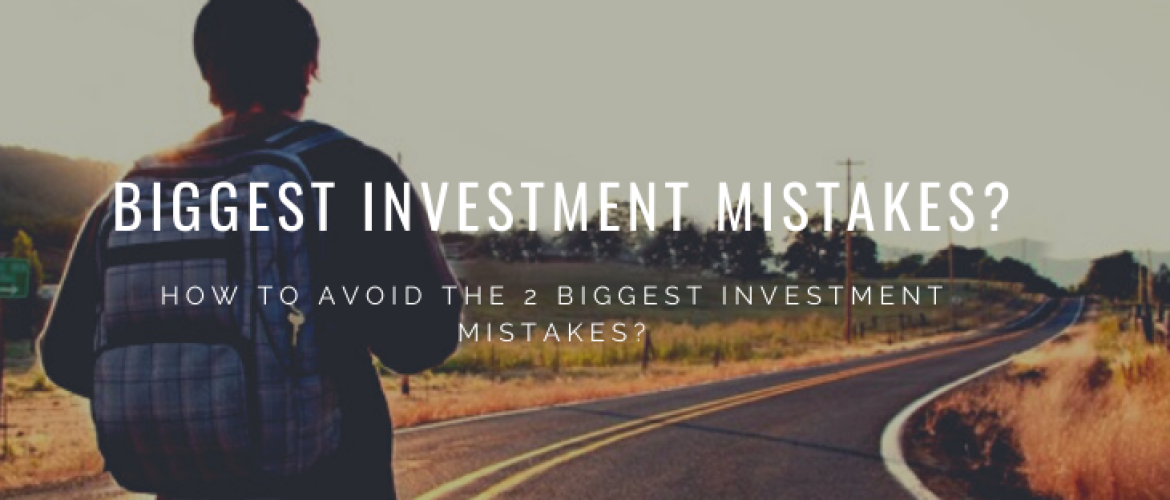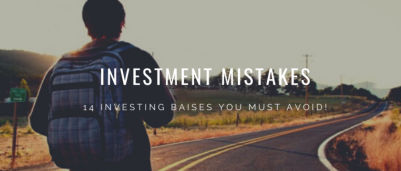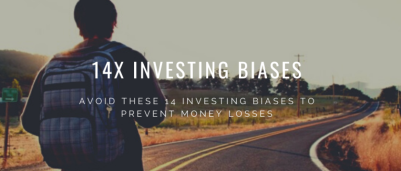Here, we highlight the 2 most prominent investment mistakes that have been identified as common among individual or retail investors, who buy and sell securities, mutual funds and ETFs through a brokerage firm or savings account (like 401(k)s). The investment mistakes are formed by underlying behavioral biases. We give tips on how to avoid the multiple underlying behavioral biases.
In particular, we look at diversification (over asset classes, location and portfolio formation) and shortsightedness (leading to present bias, regret aversion and the disposition effect).
Contents:
The First Biggest Investment Mistake: Diversification
Novice investors make three big mistakes when building an investment portfolio
How to avoid this biggest investment mistake?
The Second Biggest Investment Mistake: Shortsightedness
How to avoid this biggest investment mistake?
The First Biggest Investment Mistake: Diversification

If one were to pick a single phrase to characterize the design of the financial products on the markets it might be “pro choice”. As an individual investor you are confronted with a choice between an overwhelming, almost frighting, number of choices that you have to make for an investment. First, you must choose an asset class, for example: securities, fixed income, commodities or real estate. Then, you must choose to form your portfolio either by holding individual assets, or by buying a mutual fund or ETF. Finally, you must consider the types of risk: market or systematic risk, exchange rates, inflation rate, political risk, and interest rates.
Novice investors make three big mistakes when building an investment portfolio
Researchers (Cronqvist and Thaler, 2004) have shown that individual or retail investors make poor choices when creating an investment portfolio for the long term.[1] Firstly, their research shows that retail investors choose to hold too much equity (local and global) in their portfolio: on average 96% (!) of their wealth. Only 4% holds fixed-income securities investments (i.e., inflation-indexed bonds), and almost no investor considers private equity or hedge fund investments.
In your portfolio, also consider: real estate, commodities, corporate bonds and don’t forget to index against inflation
Too many local shares

Secondly, the researchers show that things are even worse, because 50% of the invested wealth is locally concentrated. So, only invested in the country you live in. For example, if you live in Japan, then you only hold Japanese stocks. Thus, roughly speaking, 50% of the investors is prone to the home bias. Home biases is one of the most frequent investing biases.
A simple way to avoid this major mistake in investing is to choose global ETFs. By doing so, you immediately have a lot of diversification.
You can buy the best ETF’s commission-free at eToro via this link
Too passive management of the investment portfolio
Thirdly, investors show signs of inertia or limited attention spans. The researchers find that investments of retail investors are influenced by recent returns in various segments of the market when forming their portfolio. After the portfolio has been formed, the majority of investors does not alter their portfolio anymore.
Importantly, you should also diversify your portfolio globally to avoid the “home bias”
They simply do not check frequently enough whether their holdings are still accurate and, thus, display inertia. The attention of investors is limited, since retail investors are most strongly influenced by past historical returns at the moment of creating their portfolio.
This implies that the moment of forming your portfolio has strong implications for your asset allocation holdings, because after you have formed your portfolio you stick with it.
Commission-free Crypto, Stocks and FOREX Trading with NAGA
Do you want to trade Bitcoin, Crypto, Stocks, and Forex? NAGA is one of the biggest all-in-one crypto brokers where you can buy crypto 100% commission-free. You can also use the AutoCopy to copy the Top Traders of NAGA. In fact, you can even become a Top Trader yourself and earn up to 10.000 dollars a month if you are really good at it. Anyway, this broker is perfect for anyone who wants to trade crypto 100% commission-free. You can set up an account for free and try it out.
Want to know more? Click for more information
How to avoid this biggest investment mistake?
You should diversify your portfolio well over all the existing asset classes. A good rule-of-thumb is to hold 60% of your invested wealth in risky assets (such as stocks) and 40% of your invested wealth in more risk-free assets (such as government bonds). Personally, I opt for 100% investing in stocks, ETFs, real estate and other risky investments. But note that this is very personal, and I may have a (much) higher risk profile than you.
Of course, also consider in your portfolio: real estate, commodities, corporate bonds and do not forget to index against inflation. The latter is especially important when you invest for the long run.
Importantly, diversify your portfolio also globally to avoid the home bias. You do not want to have too much local (geographical) concentration in your portfolio. Nowadays, financial markets easily help you overcome the home bias, because you can buy mutual funds and ETFs which hold small pieces of assets over the whole world. If you choose to create your portfolio by holding individual assets, then do not forget to buy non-local assets as well (i.e., consider emerging markets).
People tend to give the present more weight than the future.
For long-term investors, inertia can be troublesome. It is wise to check your portfolio occasionally, just to make sure your portfolio holdings still represent your risk-return preferences. If not, then change your portfolio based on the information you have today, but don’t let the media fool you otherwise you are prone to limited attention and you will become shortsighted.
Happy Investors Recommendation: Higher Return and Lower Risk? Tip: Asymmetrical Investing!
What if you could get higher stock returns while having less risk. Sounds too good to be true? It’s not if you know how to start with asymmetric investing. These are investments where the potential gain is greater than the potential loss. The only way for asymmetric investing is if you have a lot of knowledge and experience. This is for advanced professionals and is also used in the largest mutual funds with a minimum deposit of millions.
I’m not an expert in asymmetric investing, but I do know a very good party named Capitalist Exploits which I highly recommend. I’ve joined their Membership one year ago and it brings a lot of value for unique investment opportunities with commodities. I’m talking about +300% gains on Uranium, Copper, Agriculture, and 60+ buying opportunities. The Membership brought me a significant return on investment! These are true professionals. In addition, they also have a free newsletter where they share masterful tips and research on asymmetric investing with us once a week.
Want more information? read my full Capitalist Exploits Review and Experiences
The Second Biggest Investment Mistake: Shortsightedness

Humans have the tendency to give a stronger weight to the present than the future. Consequently, investors display this behavior in their investments. Actually, the inertia or limited attention of investors is one of the consequences of shortsighted behavior. Shortsightedness is borne by present bias: you favor a payoff today over a payoff in the future. Also, you favor a potential loss in the future over a certain loss today.
Every investor has at least encountered this once: you were confident that a certain stock had very little downside potential. However, the stock price starts to decrease. Still, you feel like your investment decision was right, so you didn’t sell the stock for a small loss. You hold on to the stock, because a loss is only a loss when you sell the position (i.e., investors think differently about paper losses and realized losses). Yet, the stock continues to decrease in price, and you eventually sell at a larger loss.
On the other hand, every investor probably also encountered at least once the following: you are confident in holding a certain stock with good upside potential. As soon as the stock price starts to rise, you sell the investment to ensure yourself of a gain. Afterwards, it turns out that holding on to the longer would have resulted in higher returns.
Researchers call the above two situations the disposition effect.
Investors tend to hold on to losing investment too long in the hope that the stock mean reverts. On the other hand, investors tend to sell winning investment too soon to lock in returns. Both effects are borne by present bias and, even worse, lead to regret: in both situations you could have chosen differently to make your outcome more favorable.
Let Money Work for You! Starting on the best investment platforms is half the battle
Are you still working hard for your money? Why don’t you consider letting the money work for you! Create passive income and attain financial freedom. Starting on the best investment platforms is half the battle. Do you want to know what the very best investment platforms are? Then click on the blue link to compare the best investment platforms now. Here you can read my independent comparison of the best online brokers for stocks, crypto, and P2P. Save money and choose the best investment platform!
How to avoid this biggest investment mistake?
For long-term investors present bias is certainly something that should be avoided. As a long-term investor you want to focus on the future rather than the present, however our instincts exactly tell us to do the opposite.
To avoid present bias, regret aversion and the disposition effect all at once set trading rules ex-ante that never change and stick to these trading rules. Using such long-term plans is also exactly how large institutional investors, such as pension funds, operate.
For example, if you lose XX% on an investment, exit the position. If the stock price rises above a pre-specified certain level, then lock in your gains. These rules should be unbreakable such that you never trade on emotion. Thus, even when markets go down, you have a sophisticated plan that you’ve thought well about so that you stick to it.
References
Cronqvist, Henrik, and Richard H. Thaler. 2004. “Design Choices in Privatized Social-Security Systems: Learning from the Swedish Experience.” American Economic Review, 94 (2): 424-428.
[1] Specifically, the research of Cronqvist and Thaler (2004) focusses on individual investment choices for retirement in Sweden.








